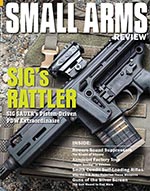SLR Prototypes: The Smith-Condit Self-Loading Rifles
By Michael Heidler | Photos by Patrick Quinn
In the years prior to World War I, the U.S. Ordnance Department was already investigating the possibility of introducing a self-loading service rifle. As early as 1904 and 1909, the office had made up lists with specific testing procedures for future self-loading weapons. From 1910 onward, several different rifles were tested, including examples from Dreyse, Madsen (Schouboe), Benét-Mercié, Bang, Kjellman, Rock Island Arsenal and Standard Arms Company. However, the performance of these weapons did not convince the military. Most of the weapons were too complicated in design, too prone to failure or difficult to handle. Only the Bang self-loading carbine was examined more closely.
One of the unsuccessful weapons was the gas-operated rifle of the Standard Arms Company. It is also known under the name “Smith-Condit Self-Loading Gas-Operated Rifle,” after its designer Morris Smith, and the company secretary of Standard Arms, W.D. Condit. The company had high hopes for their weapon projects: In 1907, a factory building in Wilmington, Delaware, was acquired by means of capital from the famous DuPont family for the production of weapons. The aim was to generate 150 new jobs and an output of 50 guns per day (according to The Iron Age Magazine, May 1907). But that came to nothing. The “Standard Semi-Automatic Sporting Rifle, Model G” sold sluggishly, and even the design as a slide-action (pump gun) “Model M” did not sell much better.
The weapons were indeed superbly manufactured and visually appealing, but they soon earned the reputation of being unreliable, because the design was prone to failure. The company got more and more into financial difficulties. The military requested some weapons for testing, leading to hope for a large order that would rescue the company. But even there, the judgment was scathing: In both trials on April 16 and June 8, 1910, in Springfield, the self-loading rifle flunked. This was mainly because it wasn’t robust enough in the eyes of the military, but also because its rate of fire was less than 90 rounds per minute and its disassembly procedure was cumbersome and required special tools. The rifle’s self-loading function and accuracy were themselves not criticized.
At the beginning of 1912, the Standard Arms Company had to cease operations due to insolvency. A year later, the company came to life again as the Standard Arms Manufacturing Company. As far as the weapons were concerned, not much had been changed; the old problems remained, and commercial success was nowhere in sight. In 1914, the company closed again—this time for good. Its inventory was sold to Bannerman, Sedgley and other arms manufacturers, who then partly completed an unknown number of weapons from the remaining parts stock and put them on the market under their own name.
From a technical standpoint, the self-loading rifle was at that time an advanced gas-operated weapon. Through a gas port drilled into the barrel, the gas pressure acted on a piston that ran inside a tube located underneath the barrel. The piston was divided into two wings at its rear end, in order to avoid the permanently integrated 5-round magazine. Upon firing, the piston would force the locking block down, and then the bolt was freed to travel rearward, extracting and ejecting the spent case and loading a new one from the magazine. The gas system could be cut off by the shooter, so that the weapon could be used as a straight-pull bolt-action rifle. This feature had been demanded by the military and was also adopted in some weapons produced for civilian use.
The contradictory information in the literature about versions of the rifle in different calibers is confusing. Depending on the source, various calibers were used (.30-06, .30/40 short, 7mm). However, that does not have to be wrong. In the course of military trials and efforts to appeal to the civilian market, the rifle could have been trialed in quite a few calibers.
Exact production figures are not known. Only seldom does one of these weapons show up for sale or at an auction. The three pieces pictured here went under the hammer at Rock Island Auctions in the U.S.
This article first appeared in Small Arms Review V22N4 (April 2018) |
| SUBSCRIBER COMMENT AREA |
Comments have not been generated for this article.












